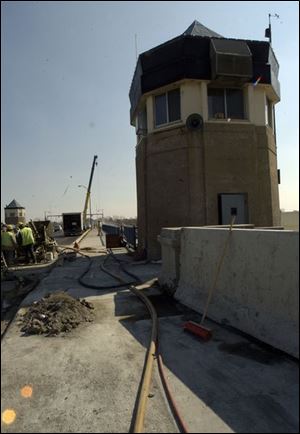
King bridge work shaping up
3/18/2005
Construction crews work one of the control towers on the Martin Luther King, Jr., Bridge.
If all goes according to schedule, the rough ride and weight limit on the Martin Luther King, Jr., Bridge's draw spans will be history a year from now.
Replacement of the steel leaves that are raised to allow Maumee River traffic to pass through the bridge is slated to be done without a major shipping disruption late this year or in the spring of 2006.
"It's workable, it's practical," Jim McKinstray, general manager of Maumee and Toledo operations for The Andersons, said yesterday. The plan calls for closing the river to all traffic between Jan. 1 and March 15 while the draw spans are replaced.
The Andersons operates two large grain elevators and fertilizer facilities on the Maumee, upriver of the bridge. December and April tend to be busy times of year for shipping.
City officials had proposed closing the river Dec. 20 and worried maritime interests further by hedging about when the bridge work might be finished the following spring.
But David Moebius, the city's commissioner of streets, bridges, and harbor, said some work requiring a river shutdown has been done this winter instead of next, which "makes us a lot more comfortable" about completing next winter's remaining work on schedule.
"There's a lot of work to be done during that short span of time," Mr. Moebius said.
During the river closing, the King's draw spans will be dismantled, half at a time, and replaced by structures now being fabricated. One lane of bridge traffic will be maintained in each direction on the half of the bridge that isn't being replaced.
The city's $33 million contract with National Engineering and Constructing of Strongsville, Ohio, allows the King to be closed to all traffic for up to four days, Mr. Moebius said. The timing and duration of any closings, he said, "will depend on the methods of installation at the time and how that goes."
Rehabilitation of the 95-year-old bridge that links Cherry and Front streets started in late 2001, when a $10.2 million first phase to modernize the structure's approach spans began. That project was finished last spring.
Last summer, National began the second phase.
The work done so far, including concrete repairs and installing banks of electrical ducts for control cables, has been mostly beneath the roadway surface, but has required daily lane closings for trucks and equipment, said Kristin Cousino, the city engineer overseeing the project.
Crews now are building the foundations for the new control towers that are to be built on the corners opposite the existing towers, Ms. Cousino said. The new towers' construction should become visible to passing traffic later this spring, she said. "You'll definitely notice them by May, if not sooner," the engineer said.
The replacement draw spans' main girders are being fabricated in Eau Claire, Wis., and are to be transported to Toledo, likely by ship, in September, Mr. Moebius said, while the control machinery is being made in Miami. Final assembly of the draw spans will be done here, and they then will be barged to the bridge site for installation next winter.
The winter shutdown could cost upriver terminals a cargo or two, but not nearly as much as they would lose if the Maumee were blocked at any time while the St. Lawrence Seaway is in operation, Mr. McKinstray said.
The seaway usually closes around Christmas and reopens the second half of March.
The Andersons had expected to send out one shipload of soybeans this winter to a processor in Windsor, Ont., but high water conditions in January forced that cargo to be diverted to trains, Mr. McKinstray said.
Contact David Patch at:
dpatch@theblade.com
or 419-724-6094.